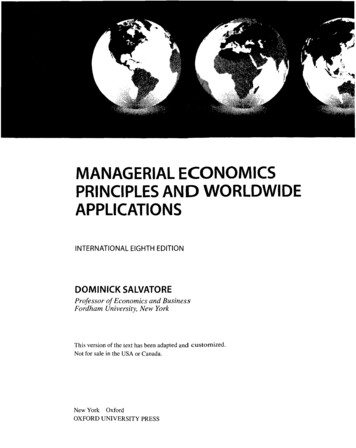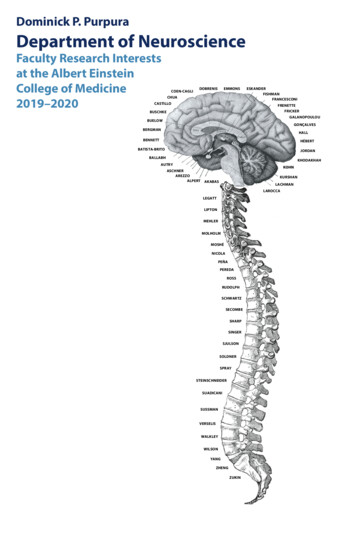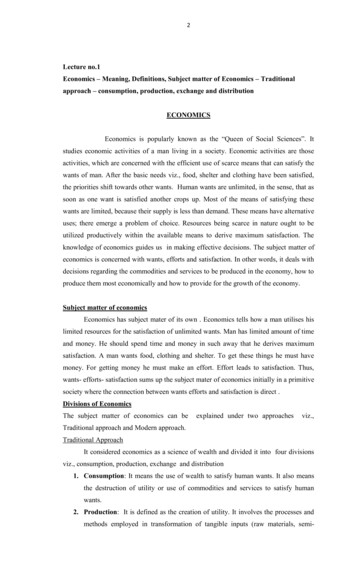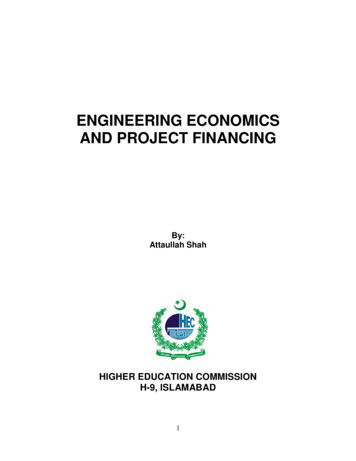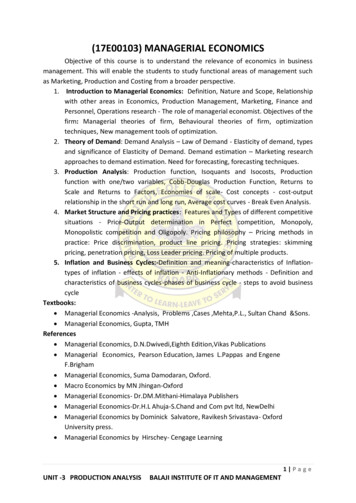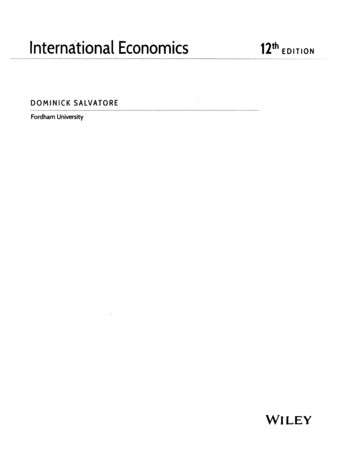
Transcription
International Economics12,h EDITIONDOMINICK SALVATOREFordham UniversityWILEY
1INTRODUCTION11.1The Globalization of the World Economy 11.1A We Live in a Global Economy 1CASE STUDY 1-1 The Dell PCs, iPhones, and iPads Sold in theUnited States are Anything but American! 21.1B The Globalization Challenge 2CASE STUDY 1-2 What Is an "American" Car? 31.2 International Trade and the Nation's Standard of Living 4CASE STUDY 1-3 Is Indias Globalization Harming the United States? 5CASE STUDY 1-4 Aising Importance of International Trade to theUnited States 71.3 The International Flow of Goods, Services, Labor, and Capital 81.3A The International Flow of Goods and Services: The Gravity Model 81.3B The International Flow of Labor and Capital 9CASE STUDY 1-5 The Gravity Model at Work 10CASE STUDY 1-6 Major Net Exporters and Importers of Capital 111.3C Globalization Before and After the Global Financial Crisis 111.4 International Economic Theories and Policies 121.4A Purpose of International Economic Theories and Policies 121.4B The Subject Matter of International Economics 131.5 Current International Economic Problems and Challenges 141.6 Organization and Methodology of the Text 161.6A Organization of the Text 161.6B Methodology of the Text 17Summary 18Key Terms 19Questions For Review 19Problems 19Appendix 20A1.1 Basic International Trade Data 20A1.2 Sources of Additional International Data and InformationSelected Bibliography (on Web)INTERNet (on Web)24
Part 12International Trade TheoryTHE LAW OF COMPARATIVE ADVANTAGE292.1 Introduction 292.2 The Mercantilists' Views on Trade 30CASE STUDY 2-1 Munn's Mercantilistic Views on Trade 30CASE STUDY 2-2 Mercantilism Is Alive and Well in the Twenty-FirstCentury 312.3 Trade Based on Absolute Advantage: Adam Smith 322.3A Absolute Advantage 322.3B Illustration of Absolute Advantage 332.4 Trade Based on Comparative Advantage: David Ricardo 332.4A The Law of Comparative Advantage 342.4B The Gains from Trade 342.4C The Case of No Comparative Advantage 362.4D Comparative Advantage with Money 36CASE STUDY 2-3 The Petition of the Candlemakers 382.5 Comparative Advantage and Opportunity Costs 382.5A Comparative Advantage and the Labor Theory of Value 382.5B The Opportunity Cost Theory 392.5C The Production Possibility Frontier Under Constant Costs 392.5D Opportunity Costs and Relative Commodity Prices 412.6 The Basis for and the Gains from Trade under Constant Costs 422.6A Illustration of the Gains from Trade 422.6B Relative Commodity Prices with Trade 432.7 Empirical Tests of the Ricardian Model 44CASE STUDY 2-4 Other Empirical Tests of the Ricardian Model 46Summary 47Key Terms 48Questions for Review 48Problems 49Appendix 50A2.1 Comparative Advantage with More Than Two Commodities 50A2.2 Comparative Advantage with More Than Two Nations 52Selected Bibliography (on Web)INTERNet (on Web)3THE STANDARD THEORY OF INTERNATIONAL TRADE3.1 Introduction 533.2 The Production Frontier with Increasing Costs 5353
3.2A Illustration of Increasing Costs 543.2B The Marginal Rate of Transformation 553.2C Reasons for Increasing Opportunity Costs and Different ProductionFrontiers 553.3 Community Indifference Curves 563.3A Illustration of Community Indifference Curves 563.3B The Marginal Rate of Substitution 573.3C Some Difficulties with Community Indifference Curves 573.4 Equilibrium in Isolation 573.4A Illustration of Equilibrium in Isolation 583.4B Equilibrium-Relative Commodity Pricesand Comparative Advantage 59CASE STUDY 3-1 The Comparative Advantage of the Largest Advancedand Emerging Economies 593.5 The Basis for and the Gains from Trade with increasing Costs 603.5A lllustrations of the Basis for and the Gains from Tradewith Increasing Costs 603.5B Equilibrium-Relative Commodity Prices with Trade 613.5C Incomplete Specialization 623.5D Small-Country Case with Increasing Costs 62CASE STUDY 3-2 Specialization and Export Concentration in SelectedCountries 633.5E The Gains from Exchange and from Specialization 63CASE STUDY 3-3 Job Losses in High U.S. Import-CompetingIndustries 64CASE STUDY 3-4 International Trade and Deindustrializationin the United States, the European Union, andJapan 653.6 Trade Based on Differences in Tastes 663.6A Illustration of Trade Based on Differences in Tastes 67Summary 68Key Terms 69Questions for Review 69Problems 69Appendix 71A3.1 Production Functions, Isoquants, Isocosts, and Equilibrium71A3.2 Production Theory with Two Nations, Two Commodities,and Two Factors 72A3.3 Derivation of the Edgeworth Box Diagram and Production Frontiers 73A3.4 Some Important Conclusions 76Selected Bibliography (on Web)INTERNet (onWeb)
XVÜi Contents4DEMAND AND SUPPLY, OFFER CURVES,, AND THEi TERMS OFJRADE794.1 Introduction 794.2 The Equilibrium-Relative Commodity Price with Trade-PartialEquilibrium Analysis 79CASE STUDY 4-1 Demand, Supply, and the International Price ofPetroleum 81CASE STUDY 4-2 The Index of Export to Import Prices for the UnitedStates 824.3 Offer Curves 824.3A Origin and Definition of Offer Curves 824.3B Derivation and Shape of the Offer Curve of Nation 1 834.3C Derivation and Shape of the Offer Curve of Nation 2 844.4 The Equilibrium-Relative Commodity Price with Trade-General EquilibriumAnalysis 854.5 Relationship Between General and Partial Equilibrium Analyses 864.6 The Terms of Trade 884.6A Definition and Measurement of the Terms of Trade 884.6B Illustration of the Terms of Trade 88CASE STUDY 4-3 The Terms of Trade of the G-7 Countries 89CASE STUDY 4-4 The Terms of Trade of Industrial and DevelopingCountries 894.6C Usefulness of the Model 90Summary 90Key Terms 91Questions for Review 91Problems 92Appendix 92A4.1 Derivation of a Trade Indifference Curve for Nation 1 93A4.2 Derivation of Nation Ts Trade Indifference Map 94A4.3 Formal Derivation of Nation Ts Offer Curve 95A4.4 Outline of the Formal Derivation of Nation 2's Offer Curve 97A4.5 General Equilibrium of Production, Consumption, and Trade 98A4.6 Multiple and Unstable Equilibria 99Selected Bibliography (on Web)INTERNet (on Web)5FACTOR ENDOWMENTS AND THE HECKSCHER-OHLIN THEORY5.1 Introduction 1015.2 Assumptions of the Theory 1025.2A The Assumptions 1025.2B Meaningof the Assumptions 102101
5.3 Factor Intensity, Factor Abundance, and the Shape of the ProductionFrontier 1035.3A Factor Intensity 1045.3B Factor Abundance 1055.3C Factor Abundance and the Shape of the Production Frontier 106CASE STUDY 5-1 Relative Resource Endowments of VariousCountries 107CASE STUDY 5-2 Capital-Labor Ratios of Selected Countries 1085.4 Factor Endowments and the Heckscher-Ohlin Theory 1095.4A The Heckscher-Ohlin Theorem 1095.4B General Equilibrium Framework of the Heckscher-Ohlin Theory 1105.4C Illustration of the Heckscher-Ohlin Theory IIICASE STUDY 5-3 Classification of Major Product Categories in Terms ofFactor Intensity 112CASE STUDY 5-4 The Factor Intensity of Trade of Various Countries 1135.5 Factor-Price Equalization and Income Distribution 1145.5A The Factor-Price Equalization Theorem 1145.5B Relative and Absolute Factor-Price Equalization 1155.5C Effect of Trade on the Distribution of Income 116CASE STUDY 5-5 Has International Trade Increased U.S. WageInequalities? 1175.50 The Specific-Factors Model 1185.5E Empirical Relevance 119CASE STUDY 5-6 Convergence of Real Wages among AdvancedCountries 1205.6 Empirical Tests of the Heckscher-Ohlin Model 1215.6A Empirical Results-The Leontief Paradox 121CASE STUDY 5-7 Capital and Labor Requirements in U.S. Trade 1225.6B Explanations of the Leontief Paradox and Other Empirical Tests of theH-O Model 123CASE STUDY 5-8 The H-O Model with Skills and Land 1255.6C Factor-Intensity Reversal 126Summary 127Key Terms 128Questions for Review 129Problems 129Appendix 130A5.1 The Edgeworth Box Diagram for Nation 1 and Nation 2 131A5.2 Relative Factor-Price Equalization 132A5.3 Absolute Factor-Price Equalization 134A5.4 Effect of Trade on the Short-Run Distribution of Income: The Specific-FactorsModel 134A5.5 Illustration of Factor-Intensity Reversal 136
A5.6 The Elasticity of Substitution and Factor-Intensity Reversal 138A5.7 Empirical Tests of Factor-Intensity Reversal 139Selected Bibliography (on Web)INTERNet (on Web)6ECONOMIES OF SCALE, IMPERFECT COMPETITION, ANDINTERNATIONAL TRADE1416.1 Introduction 1416.2 The Heckscher-Ohlin Model and New Trade Theories 1416.3 Economies of Scale and International Trade 143CASE STUDY 6-1 The New international Economies of Scale 145CASE STUDY 6-2 Job Loss Rates in U.S. Industries andGlobalization 1466.4 Imperfect Competition and International Trade 1466.4A Trade Based on Product Differentiation 146CASE STUDY 6-3 U.S. Intra-Industry Trade in AutomotiveProducts 147CASE STUDY 6-4 Variety Gains with International Trade 1486.4B Relationship Between Intra-Industry and H-O Trade Models 1496.4C Measuring Intra-Industry Trade 150CASE STUDY 6-5 Growth of Intra-Industry Trade 150CASE STUDY 6-6 Intra-Industry Trade Indexes for G-20 Countries 151CASE STUDY 6-7 Index of Intra-Industry Trade of Some U.S. Industries,2013 1526.4D Formal Model of Intra-Industry Trade 1536.4E Another Version of the Intra-Industry Trade Model 1546.5 Trade Based on Dynamic Technological Differences 1556.5A Technological Gap and Product Cycle Models 1566.5B Illustration of the Product Cycle Model 157CASE STUDY 6-8 The United States as the Most CompetitiveEconomy 1586.6 Costs of Transportation, Environmental Standards, and InternationalTrade 1596.6A Costs of Transportation and Nontraded Commodities 1596.6B Costs of Transportation and the Location of Industry 1616.6C Environmental Standards, Industry Location, and InternationalTrade 161CASE STUDY 6-9 Environmental Performance Index 162Summary 163Key Terms 164Questions for Review 164Problems 164
Appendix 165A6.1 External Economies and the Pattern of Trade 165A6.2 Dynamic External Economies and Specialization 167Selected Bibliography (on Web)INTERNet (on Web)7ECONOMIC GROWTH AND INTERNATIONAL TRADE1697.1 Introduction 1697.2 Growth of Factors of Production 1707.2A Labor Growth and Capital Accumulation over Time 1707.2B The Rybczynski Theorem 1717.3 Technical Progress 1727.3A Neutral, Labor-Saving, and Capital-Saving Technical Progress 1737.3B Technical Progress and the Nation's Production Frontier 173CASE STUDY 7-1 Growth in the Capital Stock per Worker of SelectedCountries 1757.4 Growth and Trade: The Small-Country Case 1757.4A The Effect of Growth on Trade 1767.4B Illustration of Factor Growth, Trade, and Weifare 1767.4C Technical Progress, Trade, and Weifare 178CASE STUDY 7-2 Growth in Output per Worker from Capital Deepening,Technological Change, and Improvements inEfficiency 1797.5 Growth and Trade: The Large-Country Case 1807.5A Growth and the Nation's Terms of Trade and Weifare 1807.5B7.5CImmiserizing Growth 181Illustration of Beneficial Growth and Trade 182CASE STUDY 7-3 Growth and the Emergence of New EconomicGiants 1847.6 Growth, Change in Tastes, and Trade in Both Nations 1857.6A Growth and Trade in Both Nations 1857.6B Change in Tastes and Trade in Both Nations 186CASE STUDY 7-4 Growth, Trade, and Weifare in the Leading IndustrialCountries 187Summary 187Key Terms 188Questions for Review 188Problems 189Appendix 190A7.1 Formal Proof of the Rybczynski Theorem 190A7.2 Growth with Factor Immobility 192A7.3 Graphical Analysis of Hicksian Technical Progress 193
Selected Bibliography(on Web)INTERNet (on Web)Part 28International Trade PolicyTRADE RESTRICTIONS: TARIF FS1978.1 Introduction 197CASE STUDY 8-1 Average Tariff on Nonagricultural Products in MajorDeveloped Countries 198CASE STUDY 8-2 Average Tariffs on Nonagricultural Products in SomeMajor Developing Countries 1998.2 Partial Equilibrium Analysis of a Tariff 1998.2A Partial Equilibrium Effects of a Tariff 1998.2B Effect of a Tariff on Consumer and Producer Surplus 2008.2C Costs and Benefits of a Tariff 202CASE STUDY 8-3 The Weifare Effect of Liberalizing Trade on Some U.S.Products 203CASE STUDY 8-4 The Weifare Effect of Liberalizing Trade on Some EUProducts 2048.3 The Theory of Tariff Structure 2058.3A The Rate of Effective Protection 2058.3B Generalization and Evaluation of the Theory of EffectiveProtection 206CASE STUDY 8-5 Structure of Tariffs on Industrial Products in the UnitedStates, the European Union, Japan, and Canada 207CASE STUDY 8-6 Tariff Escalation in Developed and DevelopingNations 2088.4 General Equilibrium Analysis of a Tariff in a Small Country 2088.4A General Equilibrium Effects of a Tariff in a Small Country 2098.4B Illustration of the Effects of a Tariff in a Small Country 2098.4C The Stolper-Samuelson Theorem 2118.5 General Equilibrium Analysis of a Tariff in a Large Country 2118.5A General Equilibrium Effects of a Tariff in a Large Country 2128.5B Illustration of the Effects of a Tariff in a Large Country8.6 The Optimum Tariff 2132128.6A The Meaning of the Concept of Optimum Tariff and Retaliation8.6B Illustration of the Optimum Tariff and Retaliation 214Summary 215Key Terms 216Questions for Review 216213
Problems 217Appendix 217A8.1 Partial Equilibrium Effects of a Tariff in a Large Nation 218A8.2 Derivation of the Formula for the Rate of Effective Protection220A8.3 The Stolper-Samuelson Theorem Graphically 221A8.4 Exception to the Stolper-Samuelson Theorem-The Metzler Paradox 222A8.5 Short-Run Effect of a Tariff on Factors' Income 224A8.6 Measurement of the Optimum Tariff 225Selected Bibliograph/ (on Web)INTERNet (on Web)9NONTARIFF TRADE BARRIERS AND THE NEW PROTECTIONISM2279.1 Introduction 2279.2 Import Quotas 2279.2A Effects of an Import Ouota 228CASE STUDY 9-1 The Economic Effects of the U.S. Quota on SugarImports 2299.2B Comparison of an Import Quota to an Import Tariff 2299.3 Other Nontariff Barriers and the New Protectionism 2309.3A Voluntary Export Restraints 230CASE STUDY 9-2 Voluntary Export Restraints (VERs) on JapaneseAutomobiles to the United States and Europe 2319.3B Technical, Administrative, and Other Regulations 2329.3C International Cartels 2329.3D Dumping 233CASE STUDY 9-3 Antidumping Investigations by G20 Members 2359.3E Export Subsidies 235CASE STUDY 9-4 Agricultural Subsidies in OECD Countries 236CASE STUDY 9-5 Pervasiveness of Nontariff Barriers 2379.3F Analysis of Export Subsidies 2389.4 The Political Economy of Protectionism 2399.4A Fallacious and Questionable Arguments for Protection 2399.4B The Infant-Industry and Other Qualified Arguments for Protection 2409.4C Who Gets Protected? 241CASE STUDY 9-6 Benefits to the World Economy from Complete TradeLiberalization 2429.5 Strategie Trade and Industrial Policies 2439.5A Strategie Trade Policy 2439.5B Strategie Trade and Industrial Policies with Game Theory 2449.5C The U.S. Response to Foreign Industrial Targeting and Strategie TradePolicies 245
9.6 History of U.S. Commercial Policy 2469.6A The Trade Agreements Act of 1934 2469.6B The General Agreement on Tariffs and Trade (GATT) 2479.6C The 1962 Trade Expansion Act and the Kennedy Round 2489.6D The Trade Reform Act of 1974 and the Tokyo Round 2499.6E The 1984 and 1988 Trade Acts 2499.7 The Uruguay Round, Outstanding Trade Problems, and the Doha Round 2509.7A The Uruguay Round 250CASE STUDY 9-7 Gains from the Uruguay Round 252CASE STUDY 9-8 The Multilateral Rounds of Trade Negotiations9.7B Outstanding Trade Problems and the Doha Round 254CASE STUDY 9-9 Benefits from a Likely Doha Scenario 255253Summary 256Key Terms 257Questions for Review 257Problems 258Appendix 259A9.1 Centralized Cartels 259A9.2 International Price Discrimination 260A9.3 Tariffs, Subsidies, and Domestic Goals 261Selected Bibliography (on Web)INTERNet (on Web)10 ECONOMIC INTEGRATION: CUSTOMS UNIONS AND FREETRADE AREAS10.1 Introduction 26310.2 Trade-Creating Customs Union 26410.2A Trade Creation 26410.2B Illustration ofa Trade-Creating Customs Union 26410.3 Trade-Diverting Customs Unions 26510.3A Trade Diversion 26610.3B Illustration ofa Trade-Diverting Customs Union 26610.4 The Theory of the Second Best and Other Static Weifare Effectsof Customs Unions 26710.4A The Theory of the Second Best 26710.4B Conditions More Likely to Lead to Increased Weifare 26810.4C Other Static Weifare Effects of Customs Unions 26810.5 Dynamic Benefits from Customs Unions 26910.6 History of Attempts at Economic Integration 27010.6A The European Union 270263
CASE STUDY 10-1 Economic Profile of the EU, NAFTA, and Japan 271CASE STUDY 10-2 Gains from the Single EU Market 27310.6B The European Free Trade Association 27310.6C The North American and Other Free Trade Agreements 274CASE STUDY 10-3 Mexicos Gains from NAFTA-Expectations andOutcome 27510.6D Attempts at Economic Integration Among DevelopingCountries 276CASE STUDY 10-4 Economic Profile of Mercosur 278CASE STUDY 10-5 Changes in Trade Patterns with EconomicIntegration 27910.6E Economic Integration in Central and Eastem Europe andin the Former Soviet Republics 280Summary 281Key Terms 282Questions for Review 282Problems 283Appendix 283A10.1 General Equilibrium Analysis of the Static Effectsof a Trade-Diverting Customs Union 284A10.2 Regional Trade Agreements Around the World 285Selected Bibliography (on Web)INTERNet (on Web)11INTERNAT10NAL TRADE AND ECONOMIC28711.1 Introduction 28711.2 The Importance of Trade to Development 28811.2A Trade Theory and Economic Development 28811.2B Trade as an Engine of Growth 28911.2C The Contributions of Trade to Development 29011.2D International Trade and Endogenous Growth Theory 291CASE STUDY 11-1 The East Asian Miracle of Growth and Trade 29211.3 The Terms of Trade and Economic Development 29311.3A The Various Terms of Trade 29311.3B Alleged Reasons for Deterioration in the Commodity Termsof Trade 29411.3C Historical Movement in the Commodity and Income Termsof Trade 295CASE STUDY 11-2 Change in Commodity Prices Over Time 29711.4 Export Instability and Economic Development 29811.4A Cause and Effects of Export Instability298
11.4B Measurements of Export Instability and Its Effect on Development29911.4C International Commodity Agreements 30011.5 Import Substitution versus Export Orientation 30111.5A Development Through Import Substitution versus Exports 30111.5B Experience with Import Substitution 302CASE STUDY 11-3 The Growth of GDP of Rieh Countries, Globalizers,and Nonglobalizers 30311.5C Trade Liberalization and Growth in Developing Countries 304CASE STUDY 11-4 Manufactures in Total Exports of Selected DevelopingCountries 30511.6 Current Problems Pacing Developing Countries 30511.6A Poverty in Developing Countries 30511.6B The Foreign Debt Problem of Developing Countries 307CASE STUDY 11-5 The Foreign Debt Bürden of DevelopingCountries 30711.6C Trade Problems of Developing Countries 308CASE STUDY 11-6 Globalization and World Poverty 309Summary 310Key Terms 310Questions for Review 311Problems 311Appendix 312A11.1 Income Inequalities by Traditional and Purchasing-Power Parity (PPP)Measures 312A11.2 The World by Income 313Selected BibliographyINTERNet (on Web)(on Web)12 INTERNATIONAL RESOURCE MOVEMENTS ANDMULTINATIONAL CORPORATIONS31712.1 Introduction 31712.2 Some Data on International Capital Flows 31812.3 Motives for International Capital Flows 32012.3A Motives for International Portfolio Investments 320CASE STUDY 12-1 Fluctuations in Foreign Direct Investment Flows tothe United States 32012.3B Motives for Direct Foreign Investments 322CASE STUDY 12-2 The Stock of Foreign Direct Investments Around theWorld 32312.4 Weifare Effects of International Capital Flows 32412.4A Effects on the Investing and Host Countries 32412.4B Other Effects on the Investing and Host Countries 326
12.5 Multinational Corporations 32712.5A Reasons for the Existence of Multinational Corporations 32712.5B Problems Created by Multinational Corporations in the HomeCountry 328CASE STUDY 12-3 The World's Largest Non-Petroleum, IndustrialCorporations 328CASE STUDY 12-4 Employment of U.S. MNCs Abroad 32912.5C Problems Created by Multinational Corporations in the HostCountry 33112.6 Motives for and Weifare Effects of International Labor Migration 33212.6A Motives for International Labor Migration 33212.6B Weifare Effects of International Labor Migration 33212.6C Other Weifare Effects of International Labor Migration 333CASE STUDY 12-5 U.S. Immigration and Debate over ImmigrationPolicy 335Summary 336Key Terms 337Questions for Review 337Problems 338Appendix 338A12.1 The Transfer Problem 338A12.2 International Trade, Financial and Aid Flows, and MigrationSelected Bibliography (on Web)INTERNet (on Web)339Part 3 The Balance of Payments, Foreign ExchangeMarkets, and Exchange Rates13 BALAN CE OFPAYM ENTS34513.1 Introduction 34513.2 Balance of Payments Accounting 34613.2A Current Account and Capital Account 34613.2B Financial Account 34713.2C International Transactions with Double-Entry Bookkeeping 34713.3 The International Transactions of the United States 348CASE STUDY 13-1 The Major Goods Exports and Imports of the UnitedStates 35013.4 Accounting Balances and the U.S. Balance of Payments 35113.5 The Postwar Balance of Payments of the United States 351CASE STUDY 13-2 The Exploding U.S. Trade Deficit with China 352CASE STUDY 13-3 The Major Trade Partners of the United States 353
XXVÜi Contents13.6 The Importance of the Current Account 35413.7 The International Investment Position of the United States 355CASE STUDY 13-4 The United States as a Debtor Nation 357Summary 358Key Terms 359Questions for Review 359Problems 360Appendix 360A13.1 The IMF Method of Reporting International Transactions 360Selected Bibliography (on Web)INTERNet (on Web)14 FOREIGN EXCHANGE MARKETS AND EXCHANGE RATES36514.1 Introduction 36514.2 Functions of the Foreign Exchange Markets 365CASE STUDY 14-1 The U.S. Dollar as the Dominant InternationalCurrency 367CASE STUDY 14-2 The Birth of a New Currency: The Euro 36814.3 Foreign Exchange Rates 36914.3A Equilibrium Foreign Exchange Rates 369CASE STUDY 14-3 Foreign Exchange Quotations 37114.3B Arbitrage 37214.3C The Exchange Rate and the Balance of Payments 37314.4 Spot and Forward Rates, Currency Swaps, Futures, and Options 37514.4A Spot and Forward Rates 37514.4B Foreign Exchange Swaps 37614.4C Foreign Exchange Futures and Options 377CASE STUDY 14-4 Size, Currency, and Geographica! Distribution of theForeign Exchange Market 37814.5 Foreign Exchange Risks, Hedging, and Speculation 37814.5A Foreign Exchange Risks 37814.5B Hedging 38114.5C Speculation 38214.6 Interest Arbitrage and the Efficiency of Foreign Exchange Markets14.6A Uncovered Interest Arbitrage 385CASE STUDY 14-5 Carry Trade 38514.6B Covered Interest Arbitrage 38614.6C Covered Interest Arbitrage Parity 38714.6D Covered Interest Arbitrage Margin 38914.6E Efficiency of Foreign Exchange Markets 390384
14.7 Eurocurrencyor Offshore Financial Markets 39114.7A Description and Size of the Eurocurrency Market 391CASE STUDY 14-6 Size and Growth of the Eurocurrency Market 39214.7B Reasons for the Development and Growth of the EurocurrencyMarket 39214.7C Operation and Effects of Eurocurrency Market 39314.7D Eurobond and Euronote Markets 394Summary 395Key Terms 396Questions for Review 397Problems 397Appendix 398A14.1 Derivation of the Formula for the Covered Interest Arbitrage Margin 398Selected Bibliography (on Web)INTERNet (on Web)15 EXCHANGE RATE DETERMINATION40115.1 Introduction 40115.2 Purchasing-Power Parity Theory 40215.2A Absolute Purchasing-Power Parity Theory 402CASE STUDY 15-1 Absolute Purchasing Power Parity in the RealWorld 403CASE STUDY 15-2 The Big Mac and the Law of One Price 40315.2B Relative Purchasing-Power Parity Theory 40415.2C Empirical Tests of the Purchasing-Power Parity Theory 405CASE STUDY 15-3 Relative Purchasing-Power Parity in the RealWorld 40615.3 Monetary Approach to the Balance of Payments and Exchange Rates 40715.3A Monetary Approach under Fixed Exchange Rates 40815.3B Monetary Approach under Flexible Exchange Rates 40915.3C Monetary Approach to Exchange Rate Determination 41115.3D Expectations, Interest Differentials, and Exchange Rates 412CASE STUDY 15-4 Monetary Growth and Inflation 413CASE STUDY 15-5 Nominal and Real Exchange Rates, and the MonetaryApproach 414CASE STUDY 15-6 Interest Differentials, Exchange Rates, and theMonetary Approach 41515.4 Portfolio Balance Model and Exchange Rates 41615.4A Portfolio Balance Model 41615.4B Extended Portfolio Balance Model 41815.4C Portfolio Adjustments and Exchange Rates 420
15.5 Exchange Rate Dynamics 42115.5A Exchange Rate Overshooting 42115.5B Time Path to a New Equilibrium Exchange Rate 422CASE STUDY 15-7 Exchange Rate Overshooting of the US Dollar 42415.6 Empirical Tests of the Monetary and Portfolio Balance Models and ExchangeRate Forecasting* 425CASE STUDY 15-8 The Euro Exchange Rate Defies Forecasting 427Summary 428Key Terms 429Questions for Review 429Problems 429Appendix 431A15.1 Formal Monetary Approach Model 431A15.2 Formal Portfolio Balance Model and Exchange RatesSelected Bibliography (on Web)INTERNet (on Web)432Part 4 Open-Economy Macroeconomics and theInternational Monetary System16 THE PRICE ADJUSTMENT MECHANISM WITH FLEXIBLE16.1 Introduction 43716.2 Adjustment with Flexible Exchange Rates 43816.2A Balance-of-Payments Adjustments with Exchange RateChanges 43816.2B Derivation of the Demand Curve for Foreign Exchange 43916.2C Derivation of the Supply Curve for Foreign Exchange 44016.3 Effect of Exchange Rate Changes on Domestic Prices and the Terms ofTrade 441CASE STUDY 16-1 Currency Depreciation and Inflation in DevelopingCountries duringthe 1997-1998 East AsianCrisis 44216.4 Stability of Foreign Exchange Markets 44316.4A Stable and Unstable Foreign Exchange Markets44316.4B The Marshall-Lerner Condition 44516.5 Elasticities in the Real World 44516.5A Elasticity Estimates 44616.5B The J-Curve Effect and Revised Elasticity Estimates 447CASE STUDY 16-2 Estimated Price Elasticities in InternationalTrade 448
CASE STUDY 16-3 Other Estimated Price Elasticities in InternationalTrade 449CASE STUDY 16-4 Effective Exchange Rate of the Dollar and U.S.Current Account Balance 450CASE STUDY 16-5 Dollar Depreciation and the U.S. Current AccountBalance 451CASE STUDY 16-6 Exchange Rates and Current Account Balancesduring the European Financial Crisis of the Early1990s 45216.5C Currency Pass-Through 452CASE STUDY 16-7 Exchange Rate Pass-Through to Import Prices inIndustrial Countries 45316.6 Adjustment under the Gold Standard 45416.6A The Gold Standard 45416.6B The Price-Specie-Flow Mechanism 455Summary 456Key Terms 457Questions for Review 457Problems 457Appendix 458AI6.1 The Effect of Exchange Rate Changes on Domestic Prices 458A16.2 Derivation of the Marshall-Lerner Condition 459A16.3 Derivation of the Gold Points and Gold Flows Under the Gold Standard 461Selected Bibliography (on Web)INTERNet (on Web)17 THE INCOME ADJUSTMENT MECHANISM AND SYNTHESISOF AUTOMATIC ADjUSTMENTS46517.1 Introduction 46517.2 Income Determination in a Closed Economy 46617.2A Determination of the Equilibrium National Income in a ClosedEconomy 46617.2B Multiplier in a Closed Economy 46817.3 Income Determination in a Small Open Economy 46917.3A Import Function 46917.3B Determination of the Equilibrium National Income in a Small OpenEconomy 470CASE STUDY 17-1 Income Elasticity of Imports 47117.3C Graphical Determination of the Equilibrium National Income 472CASE STUDY 17-2 Private Sector and Current Account Balances 47217.3D Foreign Trade Multiplier 474CASE STUDY 17-3 Growth in the United States and the World, and U.S.Current Account Deficits 476
XXXII ContentsCASE STUDY 17-4 Growth and Current Account Balance in DevelopingEconomies 47717.4 Foreign Repercussions 478CASE STUDY 17-5 Effect of the Asian Financial Crisis of the Late 1990son OECD Countries 47917.5 Absorption Approach 48017.6 Monetary Adjustments and Synthesis of the Automatic Adjustments 48217.6A Monetary Adjustments 48217.6B Synthesis of Automatic Adjustments 48217.6C Disadvantages of Automatic Adjustments 483CASE STUDY 17-6 Interdependence in the World Economy 484Summary 485Key Terms 486Questions for Review 486Problems 487Appendix 488AI 7.1 Derivation of Foreign Trade Multipliers with Foreign Repercussions 488A17.2 The Transfer Problem Once Again 490Selected Bibliography (on Web)INTERNet (onWeb)18 OPEN.ECONOMY MACRpECONOMIC49318.1 Introduction 493CASE STUDY 18-1 Government, Private-Sector, and Current AccountBalances in the G-7 Countries 49418.2 Internal and External Balance with Expenditure-Changing andExpenditure-Switching Policies 49618.3 Equilibrium in the Goods Market, in the Money Market, and in the Balance ofPayments 49818.4 Fiscal and Monetary Policies for Internal and External Balance with FixedExchange Rates 50018.4A Fiscal and Monetary Policies from External Balance andUnemployment 50018.4B Fiscal and Monetary Policies from External Deficit andUnemployment 50218.4C Fiscal and Monetary Policies with Elastic Capital Flows 502CASE STUDY 18-2 Relationship Between U.S. Current Account andBudget Deficits 50518.4D Fiscal and Monetary Policies with Perfect Capital Mobility 506CASE STUDY 18-3 Effect of U.S. Fiscal Policy in the United States andAbroad 50718.5 The IS-LM-BP Model with Flexible Exchange Rates 50818.5A The IS-LM-BP Model with Flexible Exchange Rates and Imperfect CapitalMobility 508
Contents XXXÜi18.5B The IS-LM-BP Model with Flexible Exchange Rates and Perfect CapitalMobility 509CASE STUDY 18-4 Effect of Monetary Policy in the United States andOther OECD Countries 51118.6 Policy Mix and Price Changes 51218.6A Policy Mix and Internal and Externa! Balance 51218.6B Evaluation of the Policy Mix with Price Changes 51418.6C Policy Mix in the Real World 515CASE STUDY 18-5 U.S. Monetary and Fiscal Policies during the PastDecade 517CASE STUDY 18-6 Deeper U.S. Recession without Strong Fiscal andMonetary Measures 51818.7 Direct Controls 51818.7A Trade Controls 51818.7B Exchange Controls 519CASE STUDY 18-7 Direct Controls on International Transactions Aroundthe World 52018.7C Other Direct Controls and International
INTERNATIONAL TRADE 141 6.1 Introduction 141 6.2 The Heckscher-Ohlin Model and New Trade Theories 141 6.3 Economies of Scale and International Trade 143 CASE STUDY 6-1 The New international Economies of Scale 145 CASE STUDY 6-2 Job Loss Rates in U.S. Industries and Globalization 146 6.4 Imperfect Competition and International Trade 146



